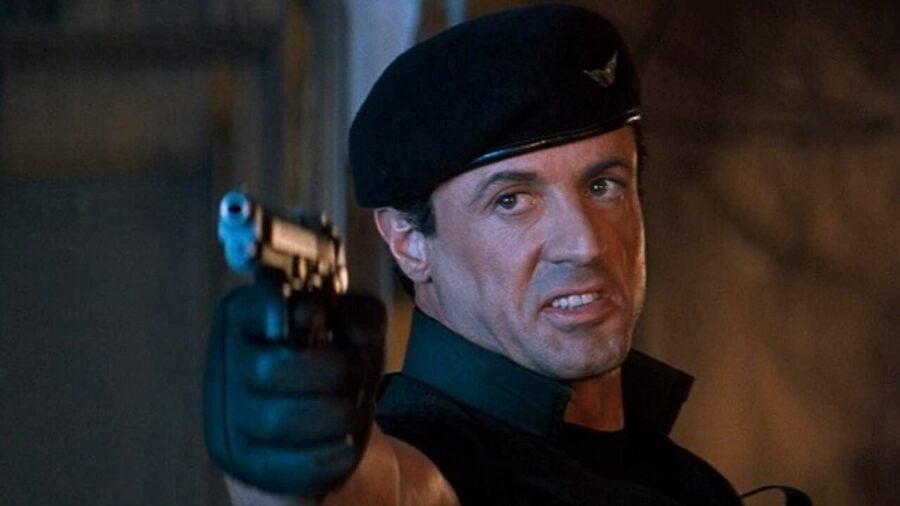
While they've become a rare breed in modern times, video games based on movies were once commonplace – in fact, they very often topped the software sales charts, as was the case with RoboCop and Tim Burton's Batman.
As the 1990s rolled on and the amazing storage power of CD-ROM became apparent, developers realised they could finally bridge the gap between live-action films and interactive entertainment in a meaningful way; no longer would film tie-ins be limited to the side-scrolling 2D platforming genre – digitised actors and full-motion video allowed for a much closer connection to the source material.
One of the earliest products to exploit this approach was Virgin Interactive's 3DO adaptation of the 1993 smash-hit Demolition Man. Starring Sylvester Stallone and Wesley Snipes in the lead roles, Marco Brambilla's flick grossed almost $160 million at the box office on an estimated budget of between $45 and $77 million, making it the ideal candidate for a transition to the world of video games.
Publisher Acclaim – infamous for bad games based on hit movies – handled the Super NES, Sega Genesis and Sega CD versions, which were your typical 2D action platformers, but Virgin charted a different path; exclusive footage of Stallone and Snipes was recorded specifically for the game itself, with the actors performing their moves in front of a green screen – something that was perhaps a novelty back in the early '90s, but would become the norm in the world of movie-making as the decades rolled by.
"We had Snipes and Stallone into the Virgin offices somewhat under duress, it seemed," explains Julian "Jaz" Rignall, who was working at Virgin at the time. "[Stallone] was contractually bound to do this. Actually getting him into the studio was a nightmare. He wasn't remotely interested in doing it. He made an effort when he did finally turn up, but jeez. The arm-twisting to make it happen."
Unlike the 16-bit versions, the 3DO version pulled together multiple styles of gameplay throughout its 16 stages. Nine of these are light-gun levels (the 3DO Gamegun peripheral is optional), but Demolition Man mixes in one-on-one fighting, racing and even a slow, somewhat plodding take on the FPS genre, where your character's radar takes up a third of the screen, making it frustratingly tricky to navigate the otherwise dull and featureless 3D corridors.
As is so often the case when a game attempts to combine disparate styles, the end result is less than the sum of its parts; each segment feels rather half-baked, and the shooting gallery sections – which take up half of the game – pale in comparison to the likes of Time Crisis and Virtua Cop, two roughly contemporary releases that make use of 3D visuals to portray their trigger-happy action. Much of the music was lifted directly from the film, but Tommy Tallarico – who, in recent years, has become something of a controversial character – composed some tunes which are exclusive to the game.
Blessed with forgettable gameplay and finding itself confined to the commercially disappointing 3DO platform, Demolition Man has largely faded from memory; a PlayStation port was apparently in development at one point, but by the time Sony's console hit shelves, the movie (and the game) will most likely have been considered old hat. Demolition Man's lasting legacy is the energetic (but somewhat misguided) performance of Stallone himself, captured against that lurid green screen for all eternity, rolling around and attempting to react to things which simply don't exist in the real world. FMV games would enjoy a brief moment of popularity during this period before the limits of their interactivity – and the arrival of powerful home systems capable of convincing 3D gameplay – reduced the genre to a footnote.






Comments 1
I mean, the execution is lacking, but the ambition on display here is pretty awesome. I only ever saw screenshots of this one as a kid (maybe in Next Gen Magazine?) , and I remember thinking it looked great. Had I owned a 3DO, this probably would have blown my mind.
This article actually makes me want to hunt down an ISO and give it a crack. I wonder how much you could improve the performance here by overclocking the cpu? 3DO emulators are good for that kind of stuff
And that Tommy Tallarico music is pretty great too - I always loved his stuff. It's a shame he's had such a fall from grace, and now we have to separate the artist from the art.
Show Comments
Leave A Comment
Hold on there, you need to login to post a comment...